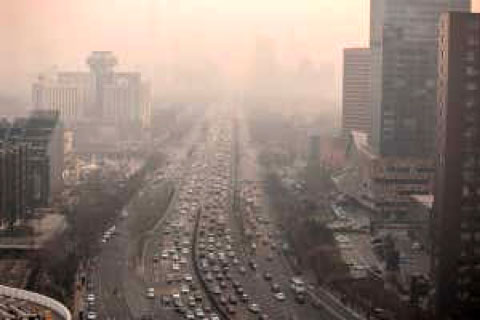[Source: NewScientist] Cities tackling one major air pollutant risk inadvertently making things worse by fuelling the growth of another, potentially more harmful type of pollution.
Many urban areas around the world are in breach of World Health Organization guidelines on PM2.5, particulate matter with a maximum diameter of 2.5 micrometres. Vehicles are a common source of this kind of pollution.
But simply reducing levels of PM2.5 pollution may not improve the safety of urban air. A Chinese-US team has found that PM2.5 plays a key role in suppressing the formation of another type of pollution in built-up areas – “ultrafine particles”. These have a diameter of under 50 nanometres, and an emerging body of work has linked them to health concerns including birth defects.

Complex chemistry
The new study shines a light on how ultrafine particles form in the real world. While most previous work on the subject has been lab-based, the researchers attempted to reflect the complex chemistry of city air with tests by a Beijing road, as well as within an enclosed chamber with a car running.
They found high concentrations of PM2.5 in polluted air suppress the formation of ultrafine particles. That’s because the larger particles capture the smaller ones as they form. The team also concluded the creation of the ultrafine particles is fuelled by another pollutant released by cars: volatile organic compounds (VOCs).
In other words, cities need to simultaneously cut PM2.5 and VOCs from cars, or risk unintentionally making ultrafine particle pollution worse. Failure to do both at the same time could be “ineffective and can even exacerbate this problem”, the researchers say.
“I’ve said before that great care is needed to avoid inadvertently worsening the situation by reducing the mass of airborne particulate matter, only to increase… the numbers and the toxicity of the ultrafine [particles] as a result,” says Barbara Maher at Lancaster University, UK, who wasn’t involved in the research.
Dropping diesel
This doesn’t mean cities with a PM2.5 problem should give up tackling it, she says. Alastair Lewis at the University of York, UK, echoes that. “I don’t think anything here fundamentally changes the imperative to reduce PM2.5 as a high policy priority,” he says.
Halting use of petrol and diesel entirely would cut both PM2.5 and the VOCs that may help ultrafine particles flourish. “Electric cars will definitely help,” says Renyi Zhang at Texas A&M University, part of the Chinese-US team. But electric models account for less than 0.5 per cent of the billion-plus vehicles on the world’s roads. They also still release some PM2.5s from tyres and brake pads.
Roy Harrison at the University of Birmingham, UK, says the balancing act of cutting PM2.5 without encouraging ultrafine particles is more of an issue for a city such as Delhi than London. That is because the Indian capital has much higher PM2.5 levels, while in the UK capital levels are much lower and therefore unlikely to have much effect upon ultrafine particle numbers. London’s air pollution problem is primarily with nitrogen dioxide, which Zhang’s research found had no bearing on ultrafine particles.
Source: NewScientist
February 3, 2020


